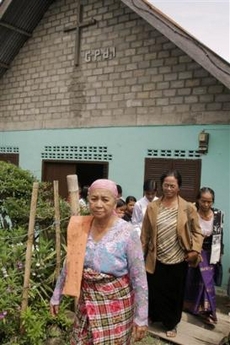Asia-Pacific
Indonesian villagers blame magic, not flu
(AP)
Updated: 2006-05-29 19:00
 |
Large Medium Small |
The three brick-and-clapboard houses stand along the village's muddy dirt road, empty and forlorn. A naked light bulb hangs from a wire over one door, still burning. A white pet bird cries for food from its cage.
 Villagers walk out of a church after they finished Sunday service in Kubu Simbelang village, North Sumatra, Indonesia, Sunday, May 28, 2006. An extended family in the village had died of bird flu and no links to sick birds could be found, raising fear of possible human-to-human infection, thus locals blame black magic, not the virus, for the deaths. [AP] |
But no one dares to go near.
Health experts have focused on the houses since an extended family started dying from bird flu and no links to sick birds could be established. They suspect limited human-to-human transmission, but say there is no need to panic because no one else in this mountain farming village has fallen ill and the virus has not mutated.
Some neighbors insist, however, that bird flu is not to blame. They are convinced black magic is at work, that ghosts now haunt their quiet Christian community of about 1,500 people.
Many are too scared to even pass by the family's houses, and some who live nearby are awakened by nightmares that they will be the next to die.
"We are so afraid just to step into that house," said a 37-year-old woman who identified herself only as Sembining. "We can't tell what we're afraid of — we're just afraid."
She lived near the victims and said the first woman who died was like a daughter to her. She recalled feeding and caring for her friend as she lay burning with fever before bird flu was ever suspected. Sembining can't understand why she, too, didn't fall ill.
"I think the family was cursed," she said. "It must be, because if it's bird flu, why only their family? Their blood?"
This is the largest cluster in a handful of cases involving bird flu passing from human to human, but scientists think it has always done so between blood relatives — not spouses. That has led some to theorize there may be a genetic susceptibility to the disease, but there is no evidence yet to support that.
Tests found no trace of the H5N1 virus in the village's poultry, and dozens of hens, roosters and chicks run freely in backyards. Pigs, cows, buffalo, dogs and barefoot children roam along the rutted road and across fields of chilies, oranges and limes.
Whatever the source of the infection, six of seven family members who tested positive for H5N1 have died. An eighth was buried before samples could be taken, but the World Health Organization considers her part of the cluster.
As their neighbors started dying, confusion and mistrust prompted villagers to stop cooperating with officials. Many refused to give blood samples, fearing they would later fall ill and suffer the fate of their neighbors.